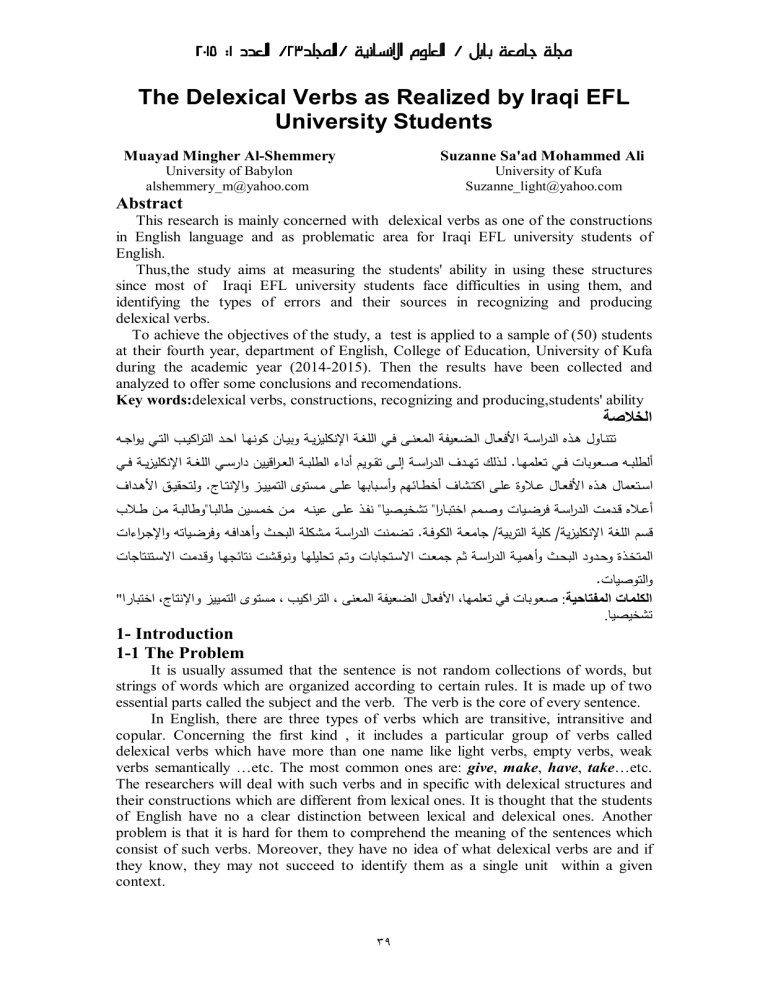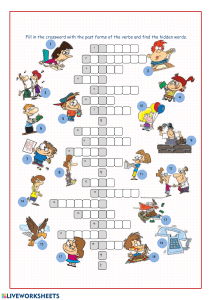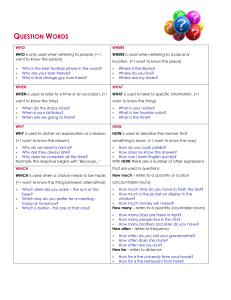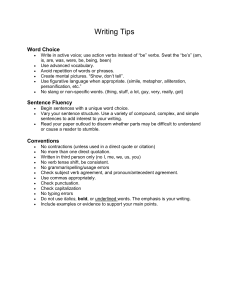
The Delexical Verbs as Realized by Iraqi EFL University Students Muayad Mingher Al-Shemmery Suzanne Sa'ad Mohammed Ali University of Babylon alshemmery_m@yahoo.com University of Kufa Suzanne_light@yahoo.com Abstract This research is mainly concerned with delexical verbs as one of the constructions in English language and as problematic area for Iraqi EFL university students of English. Thus,the study aims at measuring the students' ability in using these structures since most of Iraqi EFL university students face difficulties in using them, and identifying the types of errors and their sources in recognizing and producing delexical verbs. To achieve the objectives of the study, a test is applied to a sample of (50) students at their fourth year, department of English, College of Education, University of Kufa during the academic year (2014-2015). Then the results have been collected and analyzed to offer some conclusions and recomendations. Key words:delexical verbs, constructions, recognizing and producing,students' ability اﻟﺨﻼﺻﺔ ﺗﺗﻧــﺎول ﻫــذﻩ اﻟد ارﺳــﺔ اﻷﻓﻌــﺎل اﻟــﺿﻌﯾﻔﺔ اﻟﻣﻌﻧــﻰ ﻓــﻲ اﻟﻠﻐــﺔ اﻹﻧﻛﻠﯾزﯾــﺔ وﺑﯾــﺎن ﻛوﻧﻬــﺎ اﺣــد اﻟﺗراﻛﯾــب اﻟﺗــﻲ ﯾواﺟــﻪ ﻟــذﻟك ﺗﻬــدف اﻟد ارﺳــﺔ إﻟــﻰ ﺗﻘــوﯾم أداء اﻟطﻠﺑــﺔ اﻟﻌ ـراﻗﯾﯾن دارﺳــﻲ اﻟﻠﻐــﺔ اﻹﻧﻛﻠﯾزﯾــﺔ ﻓــﻲ.أﻟطﻠﺑــﻪ ﺻــﻌوﺑﺎت ﻓــﻲ ﺗﻌﻠﻣﻬــﺎ وﻟﺗﺣﻘﯾــق اﻷﻫــداف.اﺳــﺗﻌﻣﺎل ﻫــذﻩ اﻷﻓﻌــﺎل ﻋــﻼوة ﻋﻠــﻰ اﻛﺗــﺷﺎف أﺧطــﺎﺋﻬم وأﺳــﺑﺎﺑﻬﺎ ﻋﻠــﻰ ﻣــﺳﺗوى اﻟﺗﻣﯾﯾــز واﻹﻧﺗــﺎج أﻋــﻼﻩ ﻗــدﻣت اﻟد ارﺳــﺔ ﻓرﺿــﯾﺎت وﺻــﻣم اﺧﺗﺑــﺎ ار" ﺗﺷﺧﯾــﺻﯾﺎ" ﻧﻔــذ ﻋﻠــﻰ ﻋﯾﻧــﻪ ﻣــن ﺧﻣــﺳﯾن طﺎﻟﺑــﺎ"وطﺎﻟﺑــﺔ ﻣــن طــﻼب ﺗـﺿﻣﻧت اﻟد ارﺳـﺔ ﻣـﺷﻛﻠﺔ اﻟﺑﺣـث وأﻫداﻓـﻪ وﻓرﺿـﯾﺎﺗﻪ واﻹﺟـراءات. ﺟﺎﻣﻌـﺔ اﻟﻛوﻓـﺔ/ ﻛﻠﯾﺔ اﻟﺗرﺑﯾﺔ/ﻗﺳم اﻟﻠﻐﺔ اﻹﻧﻛﻠﯾزﯾﺔ اﻟﻣﺗﺧـذة وﺣـدود اﻟﺑﺣـث وأﻫﻣﯾـﺔ اﻟد ارﺳـﺔ ﺛـم ﺟﻣﻌـت اﻻﺳـﺗﺟﺎﺑﺎت وﺗـم ﺗﺣﻠﯾﻠﻬـﺎ وﻧوﻗـﺷت ﻧﺗﺎﺋﺟﻬـﺎ وﻗـدﻣت اﻻﺳـﺗﻧﺗﺎﺟﺎت .واﻟﺗوﺻﯾﺎت " اﺧﺘﺒﺎرا، ﻣﺴﺘﻮى اﻟﺘﻤﯿﯿﺰ واﻹﻧﺘﺎج، اﻟﺘﺮاﻛﯿﺐ، اﻷﻓﻌﺎل اﻟﻀﻌﯿﻔﺔ اﻟﻤﻌﻨﻰ، ﺻﻌﻮﺑﺎت ﻓﻲ ﺗﻌﻠﻤﮭﺎ:اﻟﻜﻠﻤﺎت اﻟﻤﻔﺘﺎﺣﯿﺔ .ﺗﺸﺨﯿﺼﯿﺎ 1- Introduction 1-1 The Problem It is usually assumed that the sentence is not random collections of words, but strings of words which are organized according to certain rules. It is made up of two essential parts called the subject and the verb. The verb is the core of every sentence. In English, there are three types of verbs which are transitive, intransitive and copular. Concerning the first kind , it includes a particular group of verbs called delexical verbs which have more than one name like light verbs, empty verbs, weak verbs semantically …etc. The most common ones are: give, make, have, take…etc. The researchers will deal with such verbs and in specific with delexical structures and their constructions which are different from lexical ones. It is thought that the students of English have no a clear distinction between lexical and delexical ones. Another problem is that it is hard for them to comprehend the meaning of the sentences which consist of such verbs. Moreover, they have no idea of what delexical verbs are and if they know, they may not succeed to identify them as a single unit within a given context. ٣٩ 1-2 The Aims of the Study The study aims at: 1- Demonstrating the meaning and the characteristics of delexical verbs. 2- Identifying the Iraqi EFL university students' performance in using these verbs. 3- Knowing the types of the students' errors and their sources. 1-3 The Hypotheses It is hypothesized that: 1- Most of Iraqi EFL students fail to use a delexical verb form instead of another. 2- Such students cannot differentiate between lexical and delexical ones. 1-4 The Procedures To validate the hypotheses, the following procedures are adopted: 1- Presenting materials related to the topic under discussion. 2- Conducting a test to find out the students' abilities in using this kind of verbs. 3- Analyzing and classifying the errors committed by the Iraqi EFL university students. 1-5 The Limits The study is restricted to the fourth year, department of English, College of Education, University of Kufa during the academic year (2014- 2015) as they have been taught this subject. 2- Delexical Verbs Delexical verbs are the most common verbs of general meaning which are followed by a frequent type of object. Generally, the noun heads in the object are derived from verbs. That object is semantically an extension of the verb and bears the major part of the meaning. The construction with the object provides greater weight than the corresponding SV type. Some of these verbs are, do, get, give, have, make, offer, pay, put, take…etc. ( Quirk et al., 1985: 750-51 ) Willis (1990 :95 ) indicates that there is a category group of verbs which do not have meaning in themselves, but they take their meaning from the nouns which come after them. They involve joining nouns which carry the essential meaning of the structure, i.e. the important part of the meaning is taken out of the verb and put into the noun. Similarly, Lock ( 1996: 82) declares that term delexical verbs are those verbs that have different ranges of meaning and they unite nouns which show most or all of the meaning of the process. That is to say, the meaning of the noun becomes the foremost one, while the meaning of the verb is neglected, i.e. the emphasis is placed on the semantic contribution of the noun. Despite the fact that they are very common verbs, there are not many of them and the mainly familiar ones are : give, make, have, take, do, get…etc. Eastwood (2002: 110) points out that there is a group of verbs which are called empty verbs since they are empty of meaning. They are all ordinary verbs and can be continuous. Such verbs can express some actions as a verb + object. He (ibid) adds that most expressions with empty verbs mean the complete action, for example: (1)- Helen went to the pool and took a swim. (2)-It was a lovely day so we had a walk. A swim means a period of swimming from start to end. A walk means a complete journey on foot which we do for pleasure. It is worth mentioning that some adjectives can be used in this pattern: (3)- She gave a quick smile. (4)- I had a good long sleep. ٤٠ Many grammarians remark that there is a number of very common verbs which are used with noun as their object to indicate simply that someone performs an action, not that someone affects or creates something. They have very little meaning when they are used in this way. The ones used most frequently as such are have, take, make and give (www. eoisabi. Org.1). In linguistics, delexical verbs are those that have little meaning of their own and they form predicates with some additional expressions that are usually nouns. Sometimes, they are called light verbs, vector verbs, explicator verbs, thin verbs or semantically weak verbs. They are similar to the auxiliary verbs regarding their meaning contribution to the clauses in which they appear. Most delexical constructions in English include a noun and are sometimes called stretched verbs. Here are examples which show delexical verbs with their structures: (5)- She had a smoke. (6)- Sam has got a reply. As the above examples, the underlined words and the delexical verbs together constitute the delexical constructions. Each of these constructions is the primary part of the sentence but the determiner a is usually not part of the delexical verb construction because it is changeable ( Web 2). One of the most important characteristics of the delexical verbs is that they are semantically weak when they are used in a delexical structure. This fact is shown by Koya (2005:226) who observes that the semantic weakness of such verbs make it hard to select the right verb in the structure related to these verbs, ( ibid: 250). Subsequently, semantic weakness of delexical verbs has its influence on the choice of the verb, as in the following examples where the verb make is used an alternative of another verb: (7)- Make a research. (8)- Make a balance. Thus, the selection of the above verb is mistaken because of the semantics weakness of the location of that verb. In other words, the position of the verb is filled with make because semantically there is no big difference in meaning between make and the right verbs. Therefore, the matter becomes very problematic. Examples are: (9)- Do a research. (10)- Strike a balance. (Hugon, 2006:15) Frequency is another fundamental characteristic of delexical verbs and it is the direct reason behind why they are being delexical. The high frequency gives them the quality of semantics weakness, therefore the most frequent meaning of delexical verbs should be chosen since frequency has shifted the foremost meaning of those verbs, (Vrbinc, 2002: 63). Leonard ( 2009: 4 ) and Koya ( 2005: 189 ) on the one hand, state that the last quality related to these verbs is collocation which refers to words that occur together in a group of phrases, and consequently delexical verbs are followed by nouns together to represent a combination that is listed under the umbrella of collocation. Some grammarians, on the other hand, avoid the term collocation and deal with the delexical verbs as multi-word verbs or verb-noun phrases. 3-Delexical Structure In this respect, delexical verbs don't become delexical unless they form a multiword unit , i.e. a delexical structure, e.g: (11)- Offer an apology. The example above shows a delexical structure in which offer is a delexical verb. The basic form of this structure may + be demonstrated as: ٤١ A delexical Verb + ( indefinite article or modifier ) + Noun = A delexical Structure It is noticeable that the first element is semantically weak and this fact is normal for this kind of verbs. The delexical structure includes a delexical verb followed by a noun. Such structure signifies a meaning of a definite verb. For example: (12)- Make a comment. The verb comment becomes a noun in the delexical structure and, consequently it conveys the central part of the meaning. It can be characterized by all of the delexicalise structure (See Gunkova, 2011:13-14). The most delexical structures involve one occurrence of the action due to the presence of an indefinite article which is the most frequent determiner used in this issue, e.g; (13)- Take a breath. (14)- Have a dream. In addition to this, the numerals one or another are also used, e.g; (15)- I have one last announcement to make. By the same token, frequency is stated by other cardinal numbers or quantifying words such as: many, each, several, every, a few, e.g; (16)- I have to make two remarks. (17)- She took a few sips of the hot coffee. ( Ibid:35) Similarly, Arndt, Harvey and Nuttal (2004:124) assert the idea that the delexical structure contains a delexical verb followed by a noun group and embodies a meaning of a definite verb. This structure is very common and frequent in modern English either in everyday language or in academic English. It includes some of the very ordinary words in language and gives the idea of smoothness in English. They (ibid) add that a delexical structure contributes to the impression of fluency in English given by a foreign user. In many cases, there is a verb which has similar meaning given by the delexical structure. For example: (18)- Look. Its meaning is nearly the same as in: (19)- Have a look. But when the word look is a verb as in: (20)- I looked round the room. Here, the focus is on the action of looking and it doesn't suggest a brief event. On the contrary, when look is a noun in a delexical structure we are naming an event, something which is brief. Thus, this structure seems to be preferable to one in which the verb is of great prominence. Verarbeitung (2004:123) clarifies saying the nouns in the delexical structure are pre-modified by obligatory pre-modified adjectives in the form of past participle. This means that the choice of the adjectives in the delexical structure depends on different strategies. Akimoto (1989: 88) also announces that the modifiers that can be used with delexical structures are defined as adjectives, possessives, and quantifiers. Moreover, there are delexical structures which require modifiers, e,g: (21)- Take a deep breath. For him, the most important modifiers that come with delexical structures are: good, quick, full, new, and fresh. It has been suggested by Duskova (2003: 420) that there is, undoubtedly, a relationship between adjectives in delexical structures and adverbs of analogous single verbs as in the following examples: (22)- Have a quick shower. (23)- To shower quickly. ٤٢ As it is pointed out by Akimoto ( 1989:192 ) that this relationship is not equivalent between the verb + adjective and the verb + adverb as in: (24)- The giants were taking their midday snooze. (25)- Luke gave another short laugh. Consequently, the delexical structures normally simplify the description of the action and particularly when there is no appropriate adverb to express the concrete attributes of the situation. Therefore, the reason behind using the delexical verbs according to modification is that noun modification is better to be used and more flexible than verb modification. 4-Delexical Verbs Vs. Lexical Verbs To begin with, the term lexical relates to the lexicon that is the dictionary or the vocabulary of a particular language. A rough difference is sometimes made between content words, that are called lexical words whose meaning is explained in terms of their lexical content, and function words that are called grammatical words whose role is mostly be clarified in terms of the grammar of a language. The term lexical verb is sometimes used for main verbs, as contrasted with auxiliary verbs. The delexical verb is a frequent and changeable lexical verb, like, give, have, make, take, do, got..etc., which is semantically weak in many of its uses, and can be joined with nouns in structures. They are called delexical when they are used in delexical structures. (26)- A. Make a decision. ( Delexical Verb) B. decide. ( Lexical Verb) (Leech, 2006: 59- 60) To add more ,the main difference that can be observed between delexical and lexical verbs is that delexical construction is more specific than the lexical one and the contrast appears clearly between these two parallel sentences: (27)- A. He lay down. B. He had a lie down. As the examples above suggest that the explanation of the difference between them is that example (A) implies that the purpose of lying down is to rest, not to, for example, undergo a medical check as in example (B), ( Huddleston and Pullum, 2002: 292). The term empty verbs is also used to refer to the delexical verbs and the purpose behind the use of these verbs is to express an action as an empty verb + object. For instance, the verb have comes as delexical while it comes as an ordinary verb or delexical verb as in the following examples: (28)- A. Have a ride. ( Delexical) B. I have a suggestion. ( Lexical) ( Eastwood, 2002:104) In brief, delexical verbs and their analogous full verbs form semantics pairs as in: (29)- A. Keep a promise. (Delexical) B. To promise. ( Lexical ) However, this does not indicate that their meanings are inevitably the same meaning, for example, the verb look means almost the same as its meaning in: (30)- Take a look. ( Sinclair,1990 :138) Similarly, Huddleston and Pullum (2002: 292) also confirm that the relationship between delexical and lexical verbs cannot be understood as full equivalence. This means that their meanings aren't exactly the same. Therefore, the choice between lexical and delexical variant is governed by several factors that are illustrated below with their examples: A. Duration, whether observed as brief or progressive, as in: ٤٣ (31)- A. Have a puff. B. Puff. B. Completion, phasing, aim, as in: (32)- A. He had a drink of my milk. B . He drank my milk. C. Modification, as in: (33)- A. Gave a cry of surprise. B. He cried. (Delexical) (Lexical) ( Delexical) ( Lexical ) (Delexical) (Lexical)(ibid.) D. End weight + avoid mentioning object, as in: (34)- A. Have a drink. ( Delexical ) B. Drink something. ( Lexical ) E. Specification + segmentation, as in,: (35)- A. Make a wish. ( Delexical ) B. To wish. ( Lexical ) (Gunkova, 2011: 32) To conclude, in the expansion of the English language, as suggested by Live (1973: 31-50) there has been a tendency in the way of splitting up the verb into two parts. The first one is nearly empty of lexical meaning, but represents the linked grammatical data, being the holder of inflectional endings. The second part carries the lexical weight, carrying verb-like meaning. 5-Test and Data Analysis Broughton et al. (1980 :145 ) believe that a test is a carefully prepared measuring instrument which has been tried out on a sample of learners using statistical techniques appropriate to educational measurement. For Hughes (1989: 13) a test is a means used to identify the students' strength and weakness and is intended primarily to ascertain what further teaching is necessary. In this respect, Schmitt (2002:267) says that a test is the act of collecting information and making judgments about language learners' knowledge of a language and ability to use it. As far as this concept is considered, the present test is made to evaluate the performance of Iraqi EFL university students in using delexical verbs. The sample of the study involves (50) students of fourth academic year (2014-2015), Department of English, College of Education, University of Kufa. The test includes two questions, the first of which concerns with measuring the students' ability at the recognition level, it is of ten items. The highest percentage of the correct answers is ( 82% ) in item ( 7 ). According to this result, it is clear that the students are familiar with the use of this item since they are exposed to many chances in dealing with structures used in forming such item, whereas the lowest percentage of the correct answers is ( 5% ) in item ( 3 ). This low rate indicates that the students are not trained enough and fail to deal with this item as they lack the necessary skill in recognizing suitable delexical verbs. This is shown in Table (1). Table (1) Students' Performance at the Recognition Level in Question (1) % No of % No. of No. of No. of incorrect correct Items Question answers answers 54 27 46 23 1 54 27 46 23 2 90 45 10 5 3 52 26 48 24 4 Q1 72 36 28 14 5 88 44 12 6 6 18 9 82 41 7 ٤٤ 34 17 66 33 8 80 40 20 10 9 54 27 46 23 10 59.6 298 40.4 202 Total Table (1) reveals the following results: 1- The total number of the correct answers is (202, 40.4 %). 2- The total number of the incorrect answers is (298, 59.6 %). It can be concluded that the students face difficulties at the recognition level as the highest rate of the incorrect answers is (298, 59.6%), whereas that of the correct answers is (202, 40.4%). This reflects that the students are not well- informed about these structures. The second question concerns with measuring the students' ability at the production level, which is also of ten items. The highest percentage of the correct answers is (18%) in item (2) and the lowest percentage of the correct answers is (2%) in items ( 1 and 10 ). Based on these rates, it can be asserted that the students do not know about the items used in forming these structures. Furthermore, they give an indication that the students really encounter difficulties in using delxeical verbs. The students' answers are illustrated in Table ( 2 ). Table (2) Students' Performance at the Production Level in Question (2) % No of % No. of No. of No. of incorrect correct Items Question answers answers 98 49 2 1 1 82 41 18 9 2 90 45 10 5 3 94 47 6 3 4 Q2 84 42 16 8 5 88 44 12 6 6 92 46 8 4 7 88 44 12 6 8 90 45 10 5 9 98 49 2 1 10 90.4 452 9.6 48 Total Table ( 2 ) shows the following results: 1- The total number of the correct answers is (48, 9.6 %). 2- The total number of the incorrect answers is ( 452, 90.4 %). It can be concluded that the students have failed to give the correct answers for the items of the production level, hence the highest rate of the incorrect answers is (452, 90.4%), whereas that of the correct answers is (48, 96 %). This reflects the students' inabilities to use such structures. Owing to the limited exposure to the language use or / and partial learning of the target language, the students try to derive wrongly rules about the data to which he /she exposed. Incomplete information or presentation of linguistic structures or elements or both may lead the students to make erroneous answers in recognizing and producing them. 6- Conclusions Considering the finding of this study, the following conclusions can be inferred: 1- Most of Iraqi EFL university students are incompetent enough to use delexical structures at the recognition and production levels. ٤٥ 2- The students cannot differentiate between lexical and delexical verbs and they are unable to disambiguate the meaning of the latter ones. 3- It is worth mentioning that the students' errors are either caused by faulty application of certain strategies of learning rules or caused by interference of the mother language or intralingual errors or both. Appendix 1 The Test Q1: Say whether each of the following underlined verbs is lexical (L)or delexical (D) . 1-Would you do a favour and post this letter for me. 2-She told me that she took a smoke yesterday. 3- He had promised not to speak loudly. 4- At the sudden, he gave a quick jump. 5- The woman got angry and hit her the thief. 6- Her parents offer a good suggestion to solve all the problems. 7- Wages are paid weekly or monthly in cash. 8- Although she is talkative, she keeps silent. 9- They put an emphasis on getting our facts right. 10- Who makes a question on what I have just said? Q2: Replace the underlined verbs with delexical structures so as to make the sentences more descriptive. You will have to change other words. 1- She ends the situation in a polite way. 2- He didn't comment on the story. 3- She decided to leave her job as she felt tire. 4- The receptionist glanced at the list of names and smiled. 5- Her parents promise to buy her a pony. 6- They apologize for missing her birthday. 7- The students look at the practical example. 8- The doctors usually work at night. 9- They visit England to take part in an activity. 10- She answers the question that she doesn't know. Appendix 2 Answers of the Test Q1: 1- Would you do a favour and post this letter for me. (D) 2-She told me that she took a smoke yesterday. (D) 3- He had promised not to speak loudly. (L) 4- At the sudden, he gave a jump. (D) 5- The woman got angry and hit her the thief. (L) 6- Her parents offer a suggestion to solve all the problems. (D) 7- Wages are paid weekly or monthly in cash. (L) 8- Although she is talkative, she keeps silent. (L) 9- They put an emphasis on getting our facts right. (D) 10- Who makes a question on what I have just said? (D) Q:2 1- She puts an end to the situation in a polite way. 2- He didn't make a comment on the story. 3-She took a decision to leave her job as she felt tire. 4- The receptionist got a glance at the list of names and smiled. ٤٦ 5- Her parents keep their promise to buy her a pony. 6- They offer an apology for missing her birthday. 7- The students have a look at the practical example. 8- The doctors usually do some work at night. 9- They pay a visit to England to take part in an activity. 10- She gives an answer to the question that she doesn't know. Bibliography Akimoto, Minoji (1989) A Study of Verbo-Nominal Structures in English. Tokyo: Shinozaki Shorin. Arndt, V., Harvey, P. and Nuttal, J. (2006) A live to Language: Perspectives on Language Teachers. Cambridge University Press. Broughton, G., Brumfit, C., Flavell, R., Hill, P. and Picas, A. (1980) Teaching English as a Foreign Language. T. J. Press (Padstow) Ltd. London. Duskova, L. (2003) A Grammar of Contemporary English against the Background of Czech. Parah: Academia. ( Third Eddition). Eastwood, J. (2002) Oxford Guide to English Grammar. New York. Gunkova, M. (2011) Teaching English Language and Literature for Secondary Schools. Corpus-Based Linguistic and Pedagogical Investigation into Delexical Verbs. Masaryk University. Huddleston, R. and Pullum G. (2002) The Cambridge Grammar of the English Language. Cambridge University Press. Hughes , A. (1989) Testing for Language Teachers. Cambridge University Press. Hugon, C. (2006) High-Frequency Verbs: Starting Block or Stumbling Block for Advanced L2 Communication: Insights from Native and Learner Corpora. Adam. Mickiewicz University. Koya, K. (2005) The Aquistion of Basic Collocations by Japanese Learners of English. Waseca University Press. Leech, G. (2006) A Glossary of English Grammar. Finland. Lenord, M. (2009) Diagnostic Writing Tool for Use with Advanced Bilingual Learners. London. Cambridge University Press. Lock, G. (2005) Functional English Grammar: An Introduction for Second Language Teachers. (8th ed.) New York. Cambridge University Press. Quirk, R., S. Greenbaum, G. Leech and J. Svartvick (1985) A Comprehensive Grammar of the English Language. London : Longman. Schmitt, N. (2002) An Introduction to Applied Linguistics. Oxford University Press. Inc. Sinclair, J.(1990) Collins Co-build English Grammar. Glasgow: Harper Collins Publisher. Verarbeitung, D., U. (2004) Structural and Functional Properties of Collocations in English. Germany. Gunter Narrverlag Tubingen. Vrbinc, M. (2002) Delexical Structures Contrastively : A Common Trap for NonNative Speakers. Studies in the English Language and Literature in Slivenia, Biro grafikaBori, Ljubljana. Volume 1. Willis, D. (1990) The Lexical Syllabus: A New Approach to Language Teaching. London and Glasgow: Collins ELT. Web Sources Web Source 1 www. eoisabi. Org. Web Source 2 . Wikipedia. Org/Wiki/Light-Verb.http://en ٤٧ ٤٨






